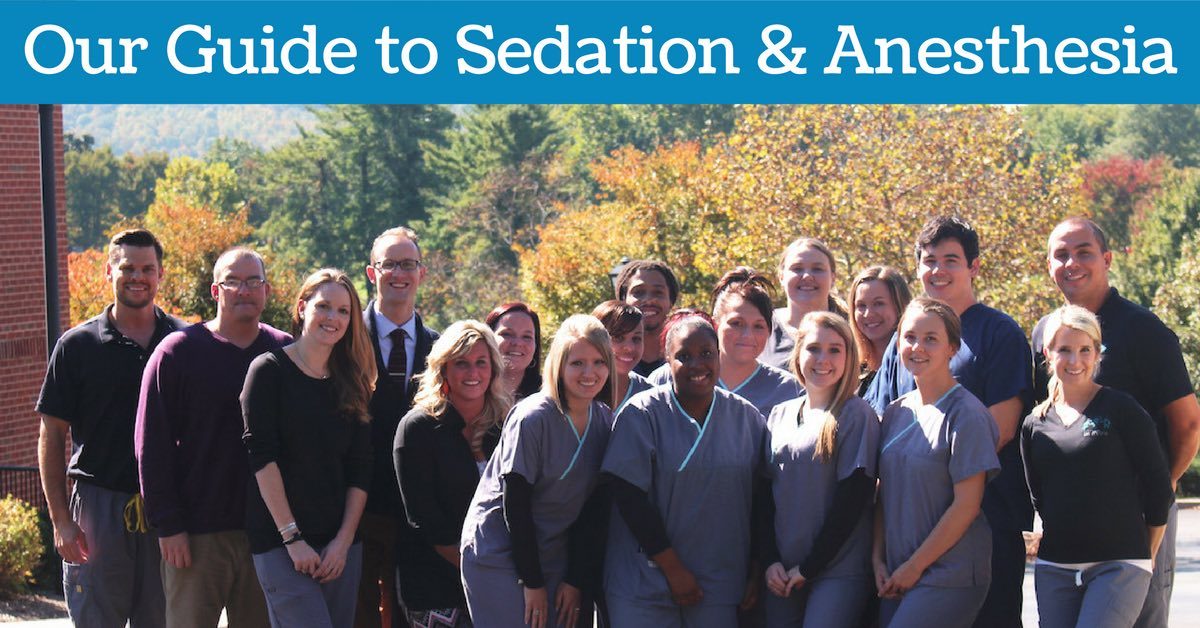If you’ve been clicking around on our website or have been referred to our practice, there’s a pretty good chance that you’ve noticed or heard that Children’s Dentistry of Charlottesville offers sedation dentistry. So– what is that and what does it mean? Today we’ll answer those and many other common questions about sedation and dental anesthesia.
Sedation dentistry helps some patients better tolerate dental procedures. Inevitably, lots of parents (and yes, even patients too!) have questions because not all dental offices offer sedation dentistry. Last month, we talked about the basics of sedation dentistry, as well as when and why we offer it to our patients.
This month, I’d like to dive deeper into the different types of sedation, or anesthesia, and further discuss what it is we do here.
Is There a Difference Between Sedation & Anesthesia?
 Dental anesthesia and sedation are phrases that are often used interchangeably, but really, they’re very different. The key difference between sedation and anesthesia is the ability to be able to follow directions. With sedation, if we tap on your shoulder and say, “take a deep breath,” you should respond by following the instruction. However, anesthesia is a state of complete sleep and unawareness to your surroundings.
Dental anesthesia and sedation are phrases that are often used interchangeably, but really, they’re very different. The key difference between sedation and anesthesia is the ability to be able to follow directions. With sedation, if we tap on your shoulder and say, “take a deep breath,” you should respond by following the instruction. However, anesthesia is a state of complete sleep and unawareness to your surroundings.
When Sedated… Still able to follow directions
When Under Anesthesia… Deep sleep and complete unawareness
Types of Dental Anesthesia & Sedation
Oral Conscious Sedation
 Oral Conscious Sedation (OCS) is a form of sedation that comes in either a pill or liquid form. The medicine used will cause drowsiness within 20-45 minutes.
Oral Conscious Sedation (OCS) is a form of sedation that comes in either a pill or liquid form. The medicine used will cause drowsiness within 20-45 minutes.
This type of sedation is the “lightest” level of sedation available. Think of it like the difference between “light” and “deep” sleep.
OCS is usually used in conjunction with nitrous oxide to further relax the patient and make treatments even easier. Because OCS generally only causes minimal drowsiness, it is best used for very short procedures with cooperative patients that may be anxious.
Intravenous Sedation
 If oral conscious sedation isn’t recommended, the next deeper level of sedation is intravenous (IV) sedation. Intravenous sedation is unique because it is very flexible and can be used to achieve a variety of results from minimal (or light) sedation, to deep (unresponsive to instructions and communication) sedation.
If oral conscious sedation isn’t recommended, the next deeper level of sedation is intravenous (IV) sedation. Intravenous sedation is unique because it is very flexible and can be used to achieve a variety of results from minimal (or light) sedation, to deep (unresponsive to instructions and communication) sedation.
Typically, with IV sedation, the patient breathes spontaneously and only requires supplemental oxygen support through a small plastic tube that rests in the nostrils, called a nasal cannula.
With IV sedation, the medications cause drowsiness just moments after they are administered, unlike OCS which takes longer to become effective. At Children’s Dentistry of Charlottesville, we will typically use deeper IV sedation for teenagers who are having their wisdom teeth extracted.
Shorter procedures that would be uncomfortable without sedation are ideal for the quicker onset and recovery time offered by IV sedation.
General Anesthesia
 If your child has more significant dental needs or doesn’t meet the criteria for the above types of sedation, there is one other option that we offer: general anesthesia. As we discussed previously, with general anesthesia the patient is completely unconscious and unaware of their surroundings.
If your child has more significant dental needs or doesn’t meet the criteria for the above types of sedation, there is one other option that we offer: general anesthesia. As we discussed previously, with general anesthesia the patient is completely unconscious and unaware of their surroundings.
There are a number of different medications that can be used for general dental anesthesia. They can be administered through an IV or by breathing the medicine through a mask or special tube.
Dental Anesthesia & Sedation Aren’t Just Black & White
When most people think of sedation and anesthesia, they imagine it working like a light switch– where on is awake and off is asleep. Instead to really help you understand sedation and anesthesia picture a spectrum that goes from black (asleep) to white (awake).

You can see that it’s not just one or the other– there are different levels of sleep and wakefulness.
With oral conscious sedation and IV sedation, responsiveness during the procedure is more common than with general anesthesia. That doesn’t mean it is likely to occur, but it is a greater possibility, and responsiveness during sedation or dental anesthesia obviously isn’t desirable. When children become more awake, unsurprisingly, they tend to react poorly.
With general anesthesia, we have a greater degree of confidence that the patient is in the darker end of the spectrum than we do with any other type of sedation. For this reason, general anesthesia works really well for young children because it is very precisely controlled by the anesthesia provider treating your child.
Another key benefit of general dental anesthesia is that we are able to more adequately protect a patient’s airway. This protection is provided by a special breathing tube allows us to administer the anesthetic medication. The tube is gently inserted through the nose and rests behind and below the tongue in the airway, thereby protecting it and providing direct access to assist with breathing, if necessary.
What Would I Do For My Family?
 The short answer is it depends on what dental procedures are necessary. For procedures on one or two teeth only, we would attempt to do it without sedation first. If that wasn’t successful, I would likely opt for general anesthesia. For multiple procedures, i.e. more than just one or two fillings, I wouldn’t hesitate to select general anesthesia.
The short answer is it depends on what dental procedures are necessary. For procedures on one or two teeth only, we would attempt to do it without sedation first. If that wasn’t successful, I would likely opt for general anesthesia. For multiple procedures, i.e. more than just one or two fillings, I wouldn’t hesitate to select general anesthesia.
So why the preference for general anesthesia over oral conscious sedation? Well, it’s less likely for a person to wake up during the procedure since the medications are stronger and remain effective as long as they are being administered. Additionally, airway complications are the most commonly encountered complications with sedation and anesthesia. It is much easier to manage an airway complication when the airway is protected with a breathing tube during general anesthesia than it is without a breathing tube.
My kids aren’t old enough to consider wisdom teeth extractions, but I have done IV sedation for two of my siblings without worry or complication.
Conclusion
Every person and every situation is different.
The best choice for one type of procedure may not be ideal for a different type of procedure. Sometimes we even recommend general anesthesia for one appointment and a deeper IV sedation for a different type of appointment for the very same patient. It all depends on the circumstances specific to that situation.
There are no “cookie-cutter” solutions. When it comes to sedation and anesthesia, “one size fits all” definitely does not apply.
Before making a recommendation for you, we will carefully consider all of the important factors:
- The patient’s medical history
- The type of dental treatment that needs to be done
- Your personal preference
We want you to be comfortable with the options that are presented to you. We are going to do everything we can to make sure every procedure is safe and successful and that you and your child have a positive experience at Children’s Dentistry of Charlottesville.
What’s Next?
Next month we are going to talk about the risks associated with anesthesia and what we do to make our sedation dentistry and general anesthesia services as safe as possible. After that topic we’ll talk about why anesthesia and sedation are becoming more common in the dental setting. And finally, we’ll finish up our series on anesthesia by walking you through an example anesthesia case in our practice.
Thanks for reading.
Keep smilin’. –Dr. Will

A graduate of Loma Linda University Dental School and a resident in the Loma Linda Dental Anesthesiology Program, Dr. Will received extensive education in pharmacology, physiology, internal medicine, and general anesthesia. Dr. Will is a member of the Special Care Dentistry Association and the American Society of Dentist Anesthesiologists. He’s also a Diplomate of the American Dental Board of Anesthesiology. Dr. Will believes every patient should be treated with kindness and respect and is focused on treating the unique dental and oral health needs of all young people.



Leave A Comment